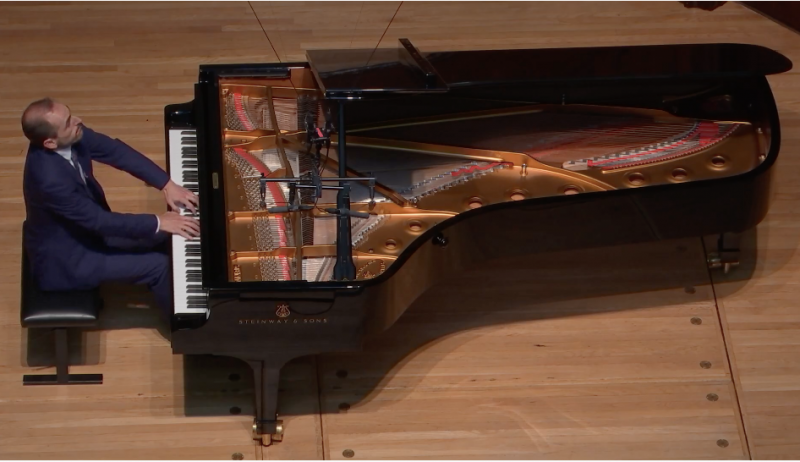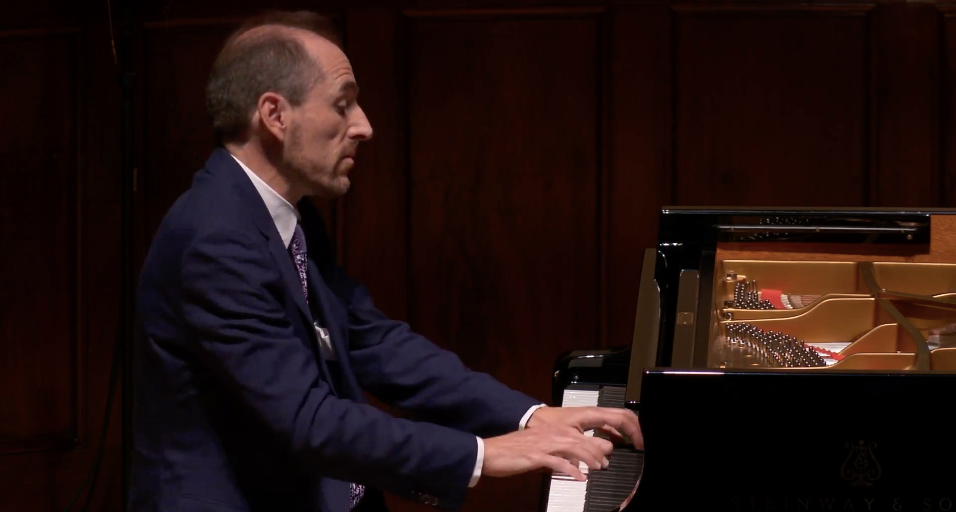Danny Driver, Wigmore Hall review - ingenious sleight-of-hand | reviews, news & interviews
Danny Driver, Wigmore Hall review - ingenious sleight-of-hand
Danny Driver, Wigmore Hall review - ingenious sleight-of-hand
The British pianist returns with an imaginative programme, gloriously played

Like many musicians, Danny Driver had not given a recital since the pandemic took hold in March.
Driver’s selection focused on the idea of études, which the best composers can make into far more than technical exercises. First, an unusual choice: a sonata by C P E Bach, the ground-breaking son of J S, whose keyboard music developed the notions of what a "sonata" really was in the mid 18th century, a piece making the most of contrasts, rather than working out one idea at a time. This sonata, the F sharp minor Wq. 52 No. 4, presents an opening movement in which an étude-like toccata and an aria seem to collide repeatedly; in Driver’s hands this was a well-argued dialogue between two different characters, and the central slow movement floated in as if from another world. While CPE Bach is probably not going to knock Beethoven off his programming perch, it’s worth reflecting that the latter would probably not have written as he did without this composer first laying the foundation.
Two Ligeti etudes, "Entrelacs" and "Fanfares," were welcome modern masterpieces, fascinating interplays of time and timbre, requiring nerves of steel and laser-sharp fingerwork. Put one note out of place and the entire edifice would crash down. Driver, though, not only presented ideal technique but the ability to define and make audible the many simultaneous strands that add up to Ligeti's dizzying sleight-of-hand. From the back of the hall, the effect is quite magical; fortunately we can also look at the streamed video to see exactly how he did it.  Finally came the Schumann Etudes symphoniques Op. 13, which effectively united the idea of fierce challenge with that of vivid contrasts. As in the C P E Bach, two personalities are in dialogue, this time Schumann’s famous alter-egos, the extrovert Florestan and introvert Eusebius; and the idea that the etudes are written “in symphonic style” can apply to the way Schumann employs the instrument’s every capability across its range - almost a type of aural 3D to be played with just ten figures. To be fair, his writing is so idiomatic that many of the work's effects could be created only on the piano; for some of the figurations an orchestral equivalent is scarcely even possible.
Finally came the Schumann Etudes symphoniques Op. 13, which effectively united the idea of fierce challenge with that of vivid contrasts. As in the C P E Bach, two personalities are in dialogue, this time Schumann’s famous alter-egos, the extrovert Florestan and introvert Eusebius; and the idea that the etudes are written “in symphonic style” can apply to the way Schumann employs the instrument’s every capability across its range - almost a type of aural 3D to be played with just ten figures. To be fair, his writing is so idiomatic that many of the work's effects could be created only on the piano; for some of the figurations an orchestral equivalent is scarcely even possible.
Driver’s tone nevertheless was rich enough for the Berlin Philharmonic’s string sections. He allowed the characterisations to shine out, with beautifully judged tempi, impeccable balance and clarity to match. Schumann’s piano in 1834 would not have had half the range and power of the Wigmore’s Steinway, and whatever the beauties and characters of early instruments, one could scarcely help wishing the composer could beam in from the beyond to hear it.
If you feel that every note in such a concert seems invested with the emotional power of three after a Covid-induced musical drought, you wouldn’t be wrong. Is that due to the performer, or to the audience members’ personal reactions? Happily, it's everything together. Perhaps that’s what concerts are for.
- Watch this recital for the next month on the Wigmore Hall website
- More classical reviews on theartsdesk
rating
Explore topics
Share this article
Add comment
The future of Arts Journalism
You can stop theartsdesk.com closing!
We urgently need financing to survive. Our fundraising drive has thus far raised £49,000 but we need to reach £100,000 or we will be forced to close. Please contribute here: https://gofund.me/c3f6033d
And if you can forward this information to anyone who might assist, we’d be grateful.

Subscribe to theartsdesk.com
Thank you for continuing to read our work on theartsdesk.com. For unlimited access to every article in its entirety, including our archive of more than 15,000 pieces, we're asking for £5 per month or £40 per year. We feel it's a very good deal, and hope you do too.
To take a subscription now simply click here.
And if you're looking for that extra gift for a friend or family member, why not treat them to a theartsdesk.com gift subscription?
more Classical music
 Kohout, Spence, Braun, Manchester Camerata, Huth, RNCM, Manchester review - joy, insight, imagination and unanimity
Celebration of the past with stars of the future at the Royal Northern College
Kohout, Spence, Braun, Manchester Camerata, Huth, RNCM, Manchester review - joy, insight, imagination and unanimity
Celebration of the past with stars of the future at the Royal Northern College
 Jansen, LSO, Pappano, Barbican review - profound and bracing emotional workouts
Great soloist, conductor and orchestra take Britten and Shostakovich to the edge
Jansen, LSO, Pappano, Barbican review - profound and bracing emotional workouts
Great soloist, conductor and orchestra take Britten and Shostakovich to the edge
 Jakub Hrůša and Friends in Concert, Royal Opera review - fleshcreep in two uneven halves
Bartók kept short, and a sprawling Dvořák choral ballad done as well as it could be
Jakub Hrůša and Friends in Concert, Royal Opera review - fleshcreep in two uneven halves
Bartók kept short, and a sprawling Dvořák choral ballad done as well as it could be
 Hadelich, BBC Philharmonic, Storgårds, Bridgewater Hall, Manchester review - youth, fate and pain
Prokofiev in the hands of a fine violinist has surely never sounded better
Hadelich, BBC Philharmonic, Storgårds, Bridgewater Hall, Manchester review - youth, fate and pain
Prokofiev in the hands of a fine violinist has surely never sounded better
 Monteverdi Choir, ORR, Heras-Casado, St Martin-in-the-Fields review - flames of joy and sorrow
First-rate soloists, choir and orchestra unite in a blazing Mozart Requiem
Monteverdi Choir, ORR, Heras-Casado, St Martin-in-the-Fields review - flames of joy and sorrow
First-rate soloists, choir and orchestra unite in a blazing Mozart Requiem
 Cho, LSO, Pappano, Barbican review - finely-focused stormy weather
Chameleonic Seong-Jin Cho is a match for the fine-tuning of the LSO’s Chief Conductor
Cho, LSO, Pappano, Barbican review - finely-focused stormy weather
Chameleonic Seong-Jin Cho is a match for the fine-tuning of the LSO’s Chief Conductor
 Classical CDs: Shrouds, silhouettes and superstition
Cello concertos, choral collections and a stunning tribute to a contemporary giant
Classical CDs: Shrouds, silhouettes and superstition
Cello concertos, choral collections and a stunning tribute to a contemporary giant
 Appl, Levickis, Wigmore Hall review - fun to the fore in cabaret and show songs
A relaxed evening of light-hearted fare, with the accordion offering unusual colours
Appl, Levickis, Wigmore Hall review - fun to the fore in cabaret and show songs
A relaxed evening of light-hearted fare, with the accordion offering unusual colours
 Lammermuir Festival 2025, Part 2 review - from the soaringly sublime to the zoologically ridiculous
Bigger than ever, and the quality remains astonishingly high
Lammermuir Festival 2025, Part 2 review - from the soaringly sublime to the zoologically ridiculous
Bigger than ever, and the quality remains astonishingly high
 BBC Proms: Ehnes, Sinfonia of London, Wilson review - aspects of love
Sensuous Ravel, and bittersweet Bernstein, on an amorous evening
BBC Proms: Ehnes, Sinfonia of London, Wilson review - aspects of love
Sensuous Ravel, and bittersweet Bernstein, on an amorous evening
 Presteigne Festival 2025 review - new music is centre stage in the Welsh Marches
Music by 30 living composers, with Eleanor Alberga topping the bill
Presteigne Festival 2025 review - new music is centre stage in the Welsh Marches
Music by 30 living composers, with Eleanor Alberga topping the bill
 Lammermuir Festival 2025 review - music with soul from the heart of East Lothian
Baroque splendour, and chamber-ensemble drama, amid history-haunted lands
Lammermuir Festival 2025 review - music with soul from the heart of East Lothian
Baroque splendour, and chamber-ensemble drama, amid history-haunted lands

Comments
Danny Driver is a master at